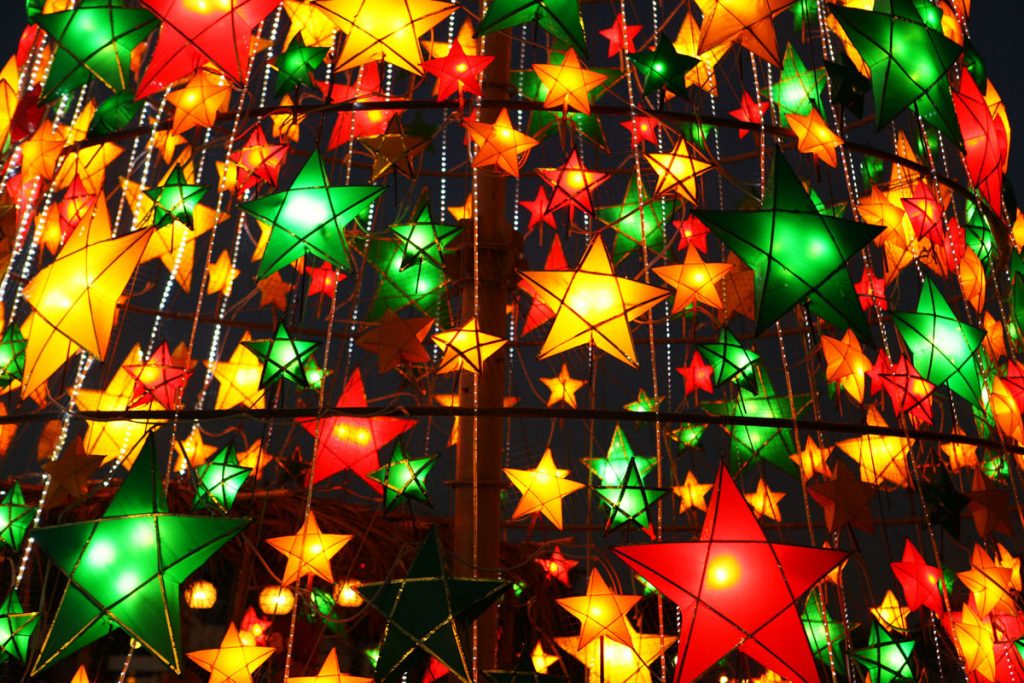Christmas is arguably the most anticipated holiday in the Philippines. After all, we have one of the longest holiday seasons, starting as early as September. And through the years, we have come up with a lot of unique customs for celebrating the occasion. Here is a rundown of beloved Pinoy Christmas traditions to relive every year.
Pinoy Christmas tradition no. 1: Caroling
Okay, so singing Christmas carols is a common tradition all over the world. What makes the Philippines stand out is how we do it. During the nine days leading to Christmas, groups of children or adults go house to house, serenading the occupants with a variety of Christmas songs. The homeowners would then reward them with money.
Caroling is an especially fun experience for the kids. Most of us have fond memories of participating in impromptu caroling runs with friends. Making the instruments for the run is also a memorable experience. Tambourines made out of flattened aluminum bottle caps and drums made from used tin cans remain a popular choice. Some may also bring guitars if they know how to play, while those without instruments will have to do with clapping their hands and singing louder.
The songs belted out are also a unique mix. Kids usually start with Sa May Bahay, Ang Aming Bati, as if asking permission from the homeowners. This is followed by the usual medley of classic Christmas songs. If all else fails, many would belt out the latest Christmas theme song from the TV networks.
At the end of the marathon of songs, carolers chant ”Thank you, thank you! Ang babait ninyo! (You’re so kind)” after the homeowner hand out the coins. Or if they reply with the dreaded “Patawad! (Sorry!),” some naughty kids will respond “Thank you! Thank you! Ang babarat ninyo! (You’re stingy!”
Pinoy Christmas traditions no. 2: Simbang Gabi (Misa de Gallo)
Even in Catholic countries, Simbang Gabi is a unique element of Paskong Pinoy. People religiously attend the nine masses set at dawn leading to Christmas. It is then capped with a mass set before Noche Buena.

One thing you might wonder about is why Simbang Gabi (night mass) is named as such even though it is held at dawn. During the early Spanish era, the Christmas novenas are held in the early evening. Due to farmers working from morning to early evening, the church decided to hold the Christmas masses in the early mornings instead as a compromise.
An interesting belief associated with this Pinoy Christmas tradition is that your wish is supposed to be granted if you complete all nine masses. No one knows when it began but it is enough to get even the most sleepyhead person waking early.
While the modern lifestyle has made it harder to wake up early to attend the nine consecutive masses, many devotees still strive to complete it. Some workers, for instance, would hear mass in a church near their workplaces.
Pinoy Christmas traditions no. 3: Monito monita
Exchanging gifts is another popular Christmas tradition around the world but Monito Monita is a unique Pinoy twist. Here, participants write their names and put them in a box. They then pick a random name from it who will be their monito or monita (if female).
The fun part is that you will choose gifts for your monito or monita based on the chosen theme. Some of the usual themes are:
- Something soft
- Something long
- Something hard
- Something sweet
- Something red
- Something wet
The different themes make for some pretty hilarious (and naughty) gift ideas that will surprise the recipient. There are often several rounds of exchanges leading up to Christmas Eve or a holiday party. At the end of the exchanges, participants will give their monitos or monitas a final gift that matches the recipient’s wishlist.

Pinoy Christmas tradition no. 4: Noche Buena
The Noche Buena or Christmas Eve dinner is the highlight of the Pinoy Christmas season. On the day before Christmas, families spend a lot of time preparing the food to be eaten for the dinner. By midnight, everyone gathers together at the table to eat the prepared food.

While there is a variety of food served on the table, you can often find the following common staples:
- Lumpia
- Fried chicken
- Pinoy-style spaghetti
- Queso de bola
- Adobo
Aside from these perennial favorites, many homemakers also have their trademark dishes. The food is often plentiful to accommodate unexpected guests like relatives or friends passing by. It is also customary for families to share food with neighbors. In return, they get dishes not on their menu.
Noche Buena is also when the exchanging of presents happens. This can be as simple as each member of the family distributing the presents they bought for everyone. Some families also hold their own monito monita event. The celebrations can often last until the early hours of Christmas as guests arrive.
Enjoy Paskong Pinoy and relive these traditions
These traditions demonstrate how wonderful Paskong Pinoy truly is. And there are still more that make Christmas a memorable experience each year. So, what are you waiting for? Star preparing and celebrating the Pinoy way.

